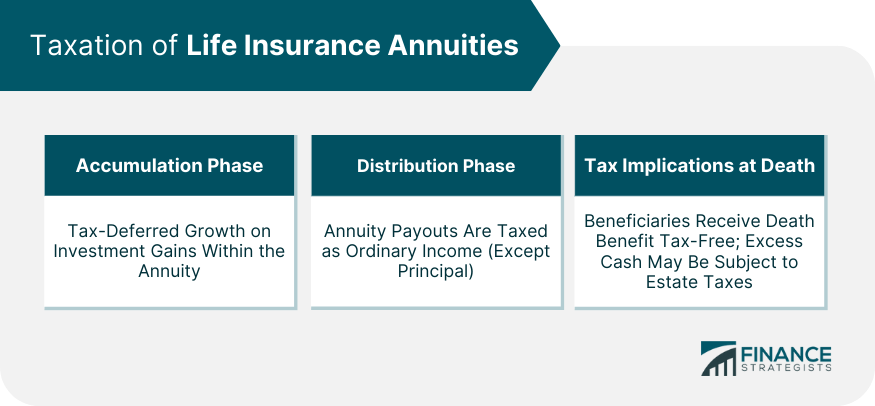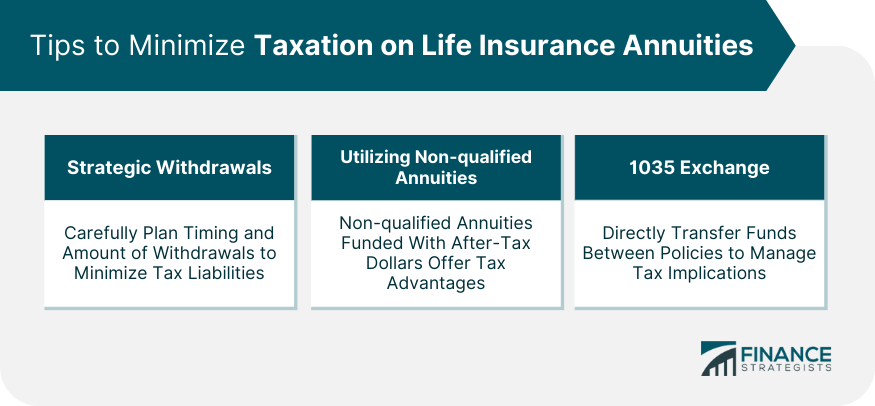Life insurance annuity, a hybrid financial product, seamlessly marries the risk protection of life insurance with the income stream of an annuity. It's a popular retirement strategy that ensures lifetime income while also providing death benefits to beneficiaries. Like a traditional annuity, you make either lump-sum or periodic payments during the accumulation phase. The insurance company then invests these funds, and they grow tax-deferred. After reaching a specified age, you begin receiving regular income payments during the annuitization phase. The tax rules surrounding life insurance annuities are somewhat complex. They differ during the accumulation and distribution phases and have unique implications upon the policyholder's death. During the accumulation phase, the growth of the annuity is tax-deferred. This means that no taxes are due on the investment gains while the money remains in the annuity. During the distribution phase, annuity payouts are typically taxed as ordinary income. However, this applies only to the portion of the payout that represents investment gains. The portion that represents the return of your original principal is not taxed. Upon the policyholder's death, the beneficiaries generally receive the death benefit free of income tax. However, if the annuity has a cash value that exceeds the policy's face value, this excess may be subject to estate taxes. Annuity payments received during the annuitization phase are subject to income tax to the extent they exceed the annuity's investment or cost basis. The cost basis refers to the total amount of premiums paid into the annuity. In a sense, these premiums have already been taxed as part of your income, so they're returned to you tax-free during annuitization. The earnings portion, however, is subject to ordinary income tax rates. Premature withdrawals, typically those made before the age of 59½, are not only taxable but are also subject to a 10% early withdrawal penalty by the IRS. This penalty applies to the taxable portion of the withdrawal. Despite the tax burdens associated with life insurance annuities, they also offer significant tax benefits, including tax-deferred growth, tax-free death benefits, and the potential for partially tax-free income. During the accumulation phase, the funds in a life insurance annuity grow tax-deferred. This allows for compound interest to work its magic, resulting in potentially higher growth compared to a similar taxable investment. The death benefit provided by life insurance annuities is generally tax-free, offering a significant advantage to beneficiaries. They can receive the death benefit without the added burden of income tax. As previously discussed, a portion of annuity payments during the annuitization phase is a return of principal and is thus not subject to income tax. This provides the potential for partially tax-free income during retirement. A 1035 exchange represents a provision in the tax code allowing the direct transfer of accumulated funds from one life insurance policy, annuity, or endowment to another without triggering a taxable event. The primary benefit of a 1035 exchange is the ability to upgrade or adjust your policy to better suit your current needs or goals without any immediate tax consequences. While a 1035 exchange can be a valuable tool, it's important to understand its tax implications. The key is that the exchange must be direct from one insurance company to another. If the funds pass through the policyholder's hands, the exchange is disqualified, and the entire gain becomes immediately taxable. Despite their growing popularity, life insurance annuities are often misunderstood, particularly when it comes to their tax implications. Addressing these misconceptions can help clarify the true tax implications of these hybrid policies. Many people mistakenly believe that because life insurance proceeds are tax-free, the same applies to life insurance annuities. This isn't the case. While the death benefit is indeed tax-free, annuity payments during the annuitization phase are generally subject to income tax. Another common misconception is that all withdrawals from a life insurance annuity are tax-free. The truth is, withdrawals are considered to come first from gains, and as such, are fully taxable until all gains have been withdrawn. After that, withdrawals come from the principal and are not taxable. By carefully planning the timing and amount of your withdrawals, you can manage the tax implications. For instance, taking withdrawals during years when you're in a lower tax bracket can result in less tax owed. Non-qualified annuities, those funded with after-tax dollars, offer tax advantages. While the earnings are still subject to tax, the portion of the payouts representing a return of your principal is tax-free. A 1035 exchange can be a powerful tool for managing the tax implications of a life insurance annuity. By directly transferring funds from one policy to another, you can avoid immediate tax liability. To illustrate the taxation in life insurance annuities, consider a hypothetical example of a retiree, John, who invested $100,000 in a life insurance annuity. Over time, his investment grows to $150,000. When he starts receiving annuity payments, part of the payout represents his original investment (which is not taxable), and part represents the gain (which is taxable). In short, $100,000 of his payout is non-taxable, while the remaining $50,000 is taxed. Life insurance annuities offer a combination of risk protection and income stream, but understanding their tax implications is crucial. During the accumulation phase, the annuity's growth is tax-deferred, providing an opportunity for tax-efficient investment growth. However, during the distribution phase, annuity payouts are generally subject to ordinary income tax, with only the portion representing the return of the principal being tax-free. Despite the tax burdens, life insurance annuities provide significant tax benefits, including tax-deferred growth, tax-free death benefits, and the potential for partially tax-free income during retirement. Utilizing strategies such as strategic withdrawals and non-qualified annuities funded with after-tax dollars can help minimize taxation. Additionally, a 1035 exchange can be used to adjust or upgrade policies without immediate tax consequences, as long as the transfer is made directly between insurance companies. Consulting with a financial professional is advisable to navigate the complexities of life insurance annuity taxation and optimize the benefits based on individual circumstances.Life Insurance Annuity: Overview
Taxation of Life Insurance Annuities
Accumulation Phase
Distribution Phase
Tax Implications at Death

When Are Life Insurance Annuity Payments Taxable?
Income Tax Considerations
Premature Withdrawal Penalties
Tax Benefits of Life Insurance Annuities
Tax-Deferred Growth
Tax-Free Death Benefit
Potential for Partially Tax-Free Income
1035 Exchange and Life Insurance Annuities
Misconceptions About Life Insurance Annuity Taxation
Tax-Free Status
Tax-Free Withdrawals
Tips to Minimize Taxation on Life Insurance Annuities
Strategic Withdrawals
Utilizing Non-qualified Annuities
1035 Exchange

Example of Life Insurance Annuity Taxation
Final Thoughts
Is Life Insurance Annuity Taxable? FAQs
Yes, annuity payments received during the annuitization phase are generally subject to income tax. However, the portion representing the return of the principal is typically not taxed.
No, the death benefit provided by life insurance annuities is generally tax-free. Beneficiaries can receive the death benefit without incurring income tax.
Yes, there are strategies to minimize taxation. One approach is strategic withdrawals, planning the timing and amount of withdrawals to take advantage of lower tax brackets. Utilizing non-qualified annuities, funded with after-tax dollars, can also offer tax advantages.
A 1035 exchange allows for the direct transfer of funds from one life insurance policy, annuity, or endowment to another without triggering a taxable event. It can be used to adjust or upgrade life insurance annuity policies without immediate tax liability, as long as the exchange is made directly between insurance companies.
No, not all withdrawals are taxable. Withdrawals are considered to come first from gains, which are fully taxable. Once all gains have been withdrawn, subsequent withdrawals from the principal are generally not subject to income tax.
True Tamplin is a published author, public speaker, CEO of UpDigital, and founder of Finance Strategists.
True is a Certified Educator in Personal Finance (CEPF®), author of The Handy Financial Ratios Guide, a member of the Society for Advancing Business Editing and Writing, contributes to his financial education site, Finance Strategists, and has spoken to various financial communities such as the CFA Institute, as well as university students like his Alma mater, Biola University, where he received a bachelor of science in business and data analytics.
To learn more about True, visit his personal website or view his author profiles on Amazon, Nasdaq and Forbes.











